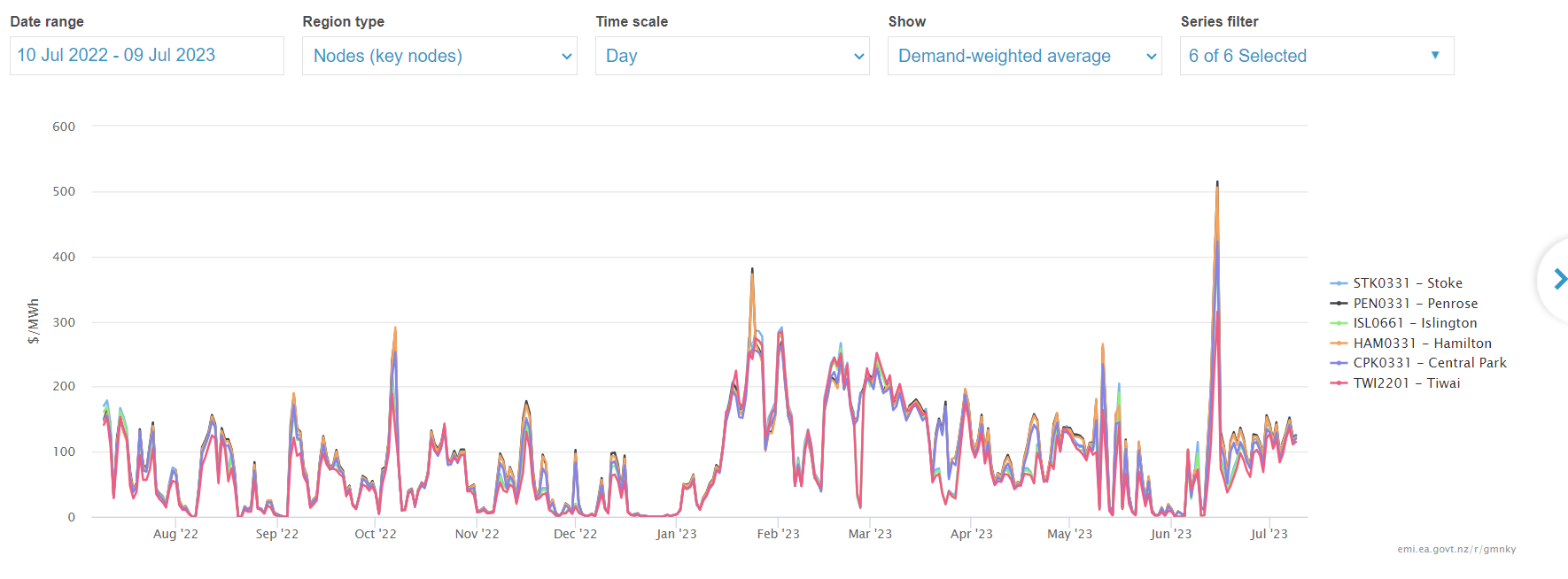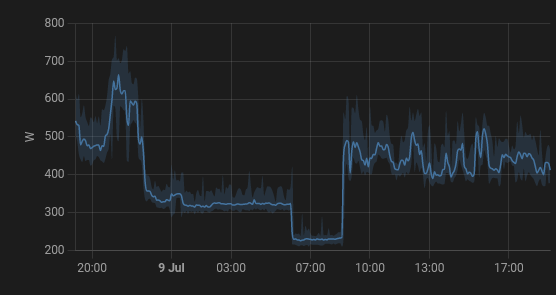Mine runs at 30watts at idle.
That powers 4 switches, 1AP, and my proxmox system (framework laptop motherboard) which runs my router and my services.
What is everyone else’s usage and what does it power?
I think I’m at 225 watts.
HP ProLiant us using 125 to 150 mostly, synology nas that consumes about 30, and I think the ubiquity stuff takes about 75 watts
Around 100w usually for:
- ccr2004
- crs309
- old epyc 7601 server (about 60w, 8 HDDs with spindown, 5 ssds and a mcx311 10G)
- homeassistant raspi separate from the main server
- poe switch for phone and ap.
All connected to a UPS so measuring is easy and power usage is constant. I would prefer lower as power cost is very high but there is not really anything significant to save at the moment as the server board has no standby function and i need it most of the time.
100W or so.
- ISP Fiber ONT
- Opnsense box (Optiplex SFF, i5-4570)
- 24 port switch
- Server (HP MT, i5-7500) with 2x SSD, 2x SAS HDD
- Server (Moderro IEC-4660, i3-7100u) with SSD, 2x USB HDD for backups
My proxmox server runs at 60W idle, which is the main Reason why I am getting a new system soon. Old one is running a old (2011 I think) dual core celeron.
25w pc with 3 SSDs and idk how much w for rpi running 2nd pihole
Why are you asking, did my wife get you to ask?
But around 300w with 24 port switch, dish shelf (3.5" disks) and server with ssd’s and 2.5" disks
I feel for those in Europe, these are the current spot prices in NZ
Edit corrected image:
I pay 0.7 EUR/kWh though it’s capped at 0.4 EUR/kWh at the moment. Which is why I make net half of my power myself. At some 1 EUR/Wp it pays off really quickly.
I approve of the y-axis label. But everything else is kinda missing… Like the information what’s depicted on the diagram. Cost of production? Price for a end-user? pre- or after tax? which country? and why did someone paint in 5 different colors? It certainly doesn’t match what i’m paying.
From New Zealand and is averaged wholesale spot prices for the 5 (main) produces here
Ah okay. Makes sense. Didn’t know that. And New Zealand has cheap electricity because of big hydroelectric plants and geothermal energy? Or is that a political decision like it is subsidized by the government by taking little taxes on energy?
Mostly hydro, It would probably be even cheaper if we didn’t subsidise big aussie firms to smelter aluminium here
Average usage for me hovers around 180-200W. I’m running the following:
- unRAID server with a Ryzen 5 5600G proc, 3 SSD/2 HDD.
- QNAP TS-251+
- Proxmox server running an i5-4460, 2 SSD/1 HDD
- UDM Base
- Unifi 8port gig switch with 3 ports providing about 12W POE, give or take.
- ISP provided modem
Given all it does for me, I’m ok with the tradeoff.
I don’t know, but my electric bill is certainly painful.
Currently my UPS is reporting 207 watts, that’s with a unraid server (3600 + 32GB ram + 2060 super for plex, and 6 drives), a mini pc for pf sense, a rpi 4 running pihole and vpn server, a single poe ap, a modem, and security cameras… it can spike to 250w with multiple encodes going on from family … but overall not bad… I did have a dedicated 20A switch installed for just my network closet as well
About 150 watts:
- Qotum i3 4 port mini pc pfSense firewall
- TP-Link 24 port managed switch
- Shuttle DH110 SFF PC running Proxmox with Coral TPU running a Home Assistant OS VM with the Coral passed through for Frigate and an Ubuntu VM running Jellyfin, *arr stack and other media stuff
- Lenovo m910q running Proxmox and a bunch of VMs for docker and testing stuff (RHEL, Debian 11, Windows 10 Enterprise N)
- HP ProDesk 400 SFF running Proxmox with a Debian 11 VM that is my “daily driver” OS
- An ancient AMD FrankenPC cobbled together from old parts that runs Ubuntu 20.04 baremetal and exists only to house a few IronWolf drives totalling about 24TB.
All of the systems except for the firewall and fileserver have i7-6700T CPUs - 4 cores, 8 threads, 35 watts. Nice chips!
110w ish. A Dell server with SSDs 370G ram, 2 sockets.
370G RAM ?!
deleted by creator
Hmm according to homeassistant my Rack+PC consumed precisely this much over the last day (graph from homeassistant). I have been trying to minimize power consumption through more efficient hardware, but you can only go so far without making big sacrifices.

wow. unless you’re doing lots of compute / AI stuff /crypto or have multiple servers or a big amount of spinning storage, i bet your 450W is far from ‘efficient’ without ‘sacrifices’. You can have one decent cpu with a few cores, one or two spinning hdd and one or two ethernet NICs idling at 20W to 40W. probably also including a few VMs with light usage.
A single Xeon in an R630 with 256GB RAM and redundant PSUs idles around 100W, and that is with no storage controller or other add-in cards, no SSDs or HDDs. Stick some storage, add-in cards and actual load and you could easily see 300W+
Add in a UPS with some conversion losses and some switches, maybe a couple PoE injectors… 600W isn’t so far away
Yes we are looking at 2-3 generation old servers, but what do you expect for a home lab? It would be silly to pay a premium for newer equipment solely in the name of efficiency as the costs will far outweigh the energy savings. If you just care about being “green” then your money could do more spent elsewhere.
Sure one can run off old domestic hardware like old laptops/PCs or SBCs like a NUC/RPi but some of us are either trying to replicate a production environment or want/need ECC memory (or both).
Please don’t belittle other people’s setup just because you might not understand their motivations/constraints or think you might be able to do it “better”.
Edit: Not to mention the parent comment said this includes his PC. My PC is a bastion of inefficiency when playing games; have you seen the TDP on current gen CPUs and GPUs?
Dude, chill. This isn’t how that works. While a server that consumes as much as a few mordern lightbulbs will almost always be something like energy efficient if it does any kind of real work… This simply isn’t the case when we’re talking about half a kilowatt. And you don’t say my pc has X components and consumes Y amount of power, therefore it’s efficient. You measure that against the job it’s doing.
It’s like with a big truck and fuel efficency. It would be very inefficient to buy a big truck only to drive your daughter to school. But the same big truck might be very efficient at hauling large quantities of stuff through the country. The same applies to your setup. Good for you, for owning a CPU, memory and so on. I too have a few generations old Xeon, ECC ram and hard disks. This doesn’t tell me anything about efficiency without knowing what you DO with all of that energy. Hence my (implied) question…
But you’re right. I wasn’t paying close attention to the diagram. It is 220W - 320W for their rack/stuff and 450W when they also start up their pc.
This is self-hosting, it is inherently inefficient.
Consolidating servers, storage, power, cooling, networking is always more efficient.
From your example: one full bus is more efficient than any configuration of even the most efficient cars.
I do this for a bunch of reasons, including being a hobby. Hobbies aren’t meant to be efficient; first and foremost they are meant to be fun 😊
Dude, chill. This isn’t how that works.
I’m pretty chill. I’m not sure attacking someone’s efficiency based on their power consumption for an unspecified rack/workload is very chill…
30 watts average for Starlink
Estimating 15 watts for the two Deco units plus the Netgear range extender (acting as Ethernet bridge to protect from lightning.)
About 100 watts for the HTPC with three usb tuners.
Between 70 watts (black) and 380 watts (white) on the old Plasma.
All running on four AGM batteries charged by solar, falling back to mains when battery drops to 20%Mine has been idling around 300-400 watts. I’ve recently been making some changes that have it running more than usual. I’m hoping in the next week I will get it back below 300 watt idle. With the space I have and the current cost of solar panels I basically offset the entire labs electric usage with about $800 worth of solar gear. So I haven’t stressed too much about electric use.
What did you get to offset the cost? I’d like to do something but idk where to start looking.
I went with simple micro-inverters (https://www.amazon.com/dp/B09N8T2741/) paired with some standard panels (https://www.amazon.com/dp/B0BRKK73QN/) Micro-inverters can’t be used when doing a full off-grid system but they are great at reducing energy bills. Super easy install that required no change to my home’s electric circuits.











